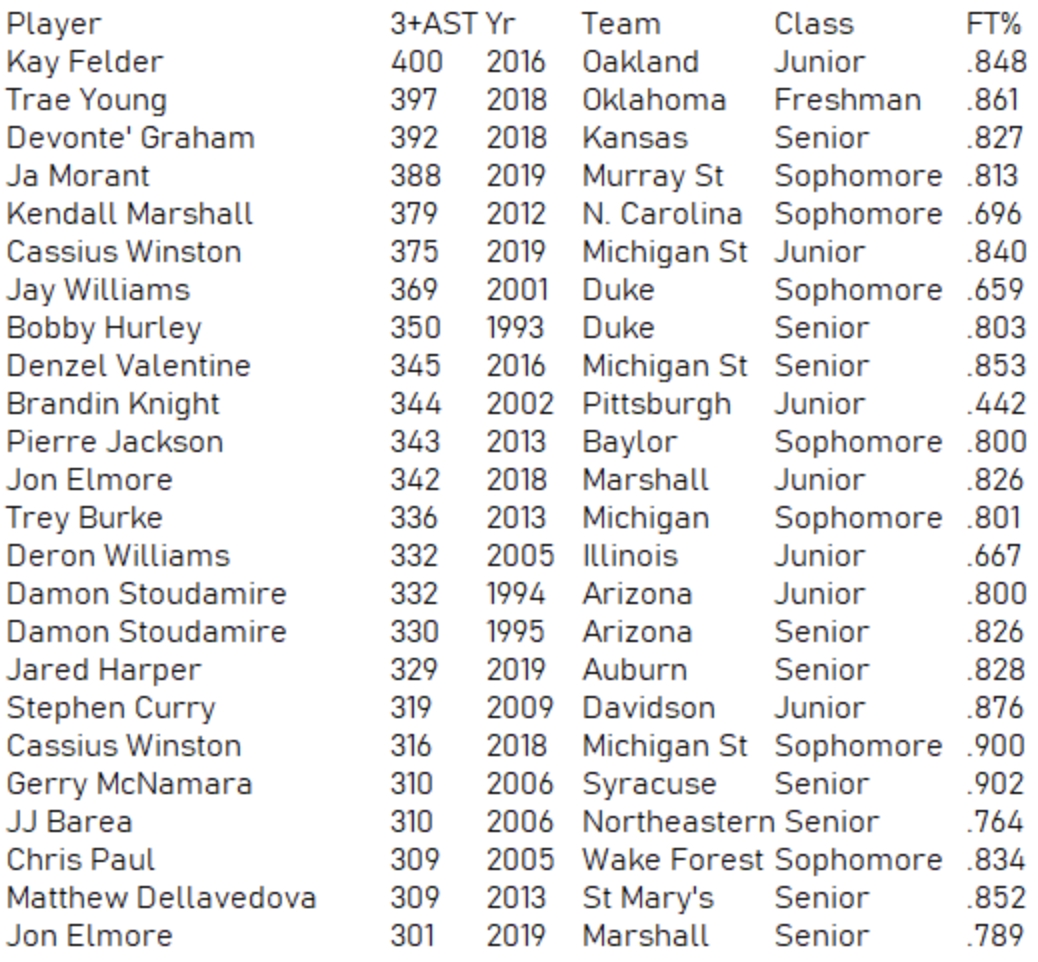One of the biggest surprises of this nascent NBA season has been the transformation of Malcolm Brogdon into a high-level point guard. Currently, Brogdon sits in the top-10 in the NBA in total assists, assist percentage, and is one of five players averaging eight or more helpers per game. His Per 36 averages of 21.9 points and 9.5 assists comfortably tops his previous career averages of 16.8 points and 4.6 assists. His assist percentage alone jumped from 16.2 percent last season to 39.9 percent this year.
While it seems like a remarkable leap for a 27 year old to make, it probably wasn’t all that hard to predict Brogdon doing this sort of thing.
Thanks to the emergence of Devonte’ Graham in Charlotte, I’ve been looking back through college and early NBA samples of players who compile a whole bunch of assists and made threes. In 2018-19, Brogdon was one of only seven players in the league with 100 made threes, 200 assists, and a True Shooting percentage of at least .600. The others were Steph Curry, Kevin Durant, James Harden, Karl-Anthony Towns, J.J. Redick, and D.J. Augustin — four superstars and two guys who have been around forever in part due to their ability as pull-up shooters.
Efficient shooting and good decision making has always been Brogdon’s M.O. During his senior season at Virginia, he was one of only seven major conference players in America with at least 75 made threes, 100 assists, and a .575 TS%. The others: Ryan Arcidiacono, Yogi Ferrell, London Perrantes, Grayson Allen, Denzel Valentine, and the aforementioned Graham. Of those seven players, Brogdon had the fewest turnovers, giving the ball away a mere 52 times (second place, funny enough, was Graham).
Looking at the college numbers of a guy like Graham makes the efficacy of high numbers of threes + assists (which we’ll call threesists, because why not) even more of a predictor of future NBA success. Not that this is some advanced metric or anything, and it can certainly be derailed by other factors, but looking through recent NCAA history, there are 81 different instances of a player with at least 250 combined threes + assists since 1993. Only eight of those players never played in the NBA, while 32 of those players were first round draft picks.
To narrow things down a little more, here’s everyone with at least 300 threesists in a season.

You’ll notice here that with the exception of injury/off-court issues, inability to shoot, or obvious athletic deficiencies, everyone here was able to carve out some sort of lengthy NBA career. You’ll also notice that Graham had the third-best season by this metrick, totaling only five fewer combined threes and assists as Trae Young, in the same year, in the same conference.
If you’re looking for someone to make a Brogdon or Graham-like leap from relative obscurity (at least as a lead guard) to legitimate, full-time playmaking responsibilities, there are some candidates currently in the NCAA. Decision-making and three-point shooting are arguably as important now as they ever have been in the history of the sport, so looking forward to the 2020 draft, there are a few players who have what it takes move into that 300-350+ range.
The aforementioned Winston — who is on pace to become the only player to make this list three times — Duke’s Tre Jones, Pepperdine’s Colbey Ross, New Mexico’s JaQuan Lyle, Ohio’s Jason Preston, Arizona’s Nico Mannion, Minnesota’s Marcus Carr, and Iowa State’s Tyrese Haliburton all stick out. Haliburton in particular is an interesting test case for this kind of analysis, given that he has 46 combined threesists in only four games, putting him on pace for well over 350. He was a 40 percent three point shooter last season and is only 5-17 (29.4 percent) thus far in 2019-20. If those makes start ticking up, he could find himself threatening for the all-time NCAA record in this stat I just made up.
Anyway, this stuff is important. The best kind of role players are ones who are good at multiple things and don’t make mistakes. If you can find an offensive engine who does those things, like Young or Ja Morant (high turnovers are not necessarily as sign of mistakes for a point guard!), you obviously pull the trigger on them as highly as you can get them. But every good team needs a guy like Brogdon, Graham, or Winston, and when they’re available in the second round of the draft, the value they can provide is immeasurable.







